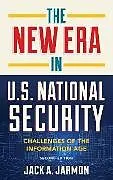The purpose of The New Era in U.S. National Security: Challenges of the Information Age is to make its readers aware of how the tensions between opposing forces from above and below influence world events and shape U.S. national security institutions. The debt trap now being experienced by the developing world has unleashed global migration on a mass scale. In a world where market forces are politically unaccountable, crime will prosper, and its linkage to organizing social structures is organic. The nexus between corrupt politicians, transnational business, and cross-border crime pulls tighter.
Meanwhile, the structures of global governance are immature. Differences of agreement over international norms and controls regarding the use of the Internet, and the laws pertaining to the deployment of cyber weapons are illusive - if not insurmountable. The chasm between the rich and poor is widening and deepening. Hostilities continue mount.
In this book, Jack A. Jarmon offers a survey of the altering landscape of warfare and competition. Using recent events and documented experiences as examples, it reveals truths about the threat from criminals, terrorists, hostile governments, and internal vulnerabilities. The nation's exposure invites attack with every hour. Rather than an abstract threat, these unseen and unreported assaults land blows to our information networks, infrastructure, quality of life, and democratic system.
Autorentext
Jack A. Jarmon has taught international relations at the University of Pennsylvania, the John C. Whitehead School of Diplomacy and International Relations at Seton Hall University, and Rutgers University where he was also Associate Director of the Command, Control and Interoperability Center for Advanced Data Analysis - a Center of Excellence of the Department of Homeland Security (Science and Technology Division). During Russia's economic transition period, he was USAID technical advisor for the Russian Federation central government. He worked for the Russian Privatization Committee in the mid 1990s and with such organizations as the US Russia Investment Fund, European Bank of Reconstruction and Development, and various money center banks.
Dr. Jarmon's private sector career includes global consultant firms, technology companies, and financial institutions. He was a manager with Arthur Andersen in Moscow and Director of Strategic Alliances at Nortel Networks, Brampton, Ontario. He studied Soviet and Russian affairs at Fordham University and the Harriman Institute at Columbia University. Jarmon is fluent in Russian and holds a doctorate degree in global affairs from Rutgers University.
Dr. Jarmon is the coauthor (with Bruce Newsome) of A Practical Introduction to Homeland Security and Emergency Management and The Cyber Threat and Globalization: The Impact on U.S. National and International Security (with Pano Yannakogeorgos).
Zusammenfassung
The purpose of The New Era in U.S. National Security: Challenges of the Information Age is to make its readers aware of how the tensions between opposing forces from above and below influence world events and shape U.S. national security institutions. The debt trap now being experienced by the developing world has unleashed global migration on a mass scale. In a world where market forces are politically unaccountable, crime will prosper, and its linkage to organizing social structures is organic. The nexus between corrupt politicians, transnational business, and cross-border crime pulls tighter.
Meanwhile, the structures of global governance are immature. Differences of agreement over international norms and controls regarding the use of the Internet, and the laws pertaining to the deployment of cyber weapons are illusive - if not insurmountable. The chasm between the rich and poor is widening and deepening. Hostilities continue mount.
In this book, Jack A. Jarmon offers a survey of the altering landscape of warfare and competition. Using recent events and documented experiences as examples, it reveals truths about the threat from criminals, terrorists, hostile governments, and internal vulnerabilities. The nation's exposure invites attack with every hour. Rather than an abstract threat, these unseen and unreported assaults land blows to our information networks, infrastructure, quality of life, and democratic system.
Inhalt
Preface
1. The National Security Establishment
The United State and the World Stage
A Brief History of the Structure
The New Reorganization
Budgeting, and Planning in Support of Policy
Striking a Balance between Domestic and Foreign Affairs
Conclusion
2. Policies and Process and the New Geopolitics
Evolution of Strategy
An Era of New Weaponry and Geopolitics
The Role of the Private Sector
The Status and Future of DHS
Conclusion
3. Irregular Warfare and Information Age Weapons
Asymmetric Warfare
A World of Weapons
The Phenomenon of Social Media
The Weaponization of Social Media
Audience Mapping, Targeted Messaging, and Kompromat
The Weaponization of Information
Conclusion
4. Conflict and Economics
Technology, the Information Age, and the Costs of War
Global Economics and Migration
The Rise of Kleptocracy
Non-Asymmetric Warfare
Conclusion
5. A Vast and Contested Domain
Information Technology vs Operational Technology
National Critical Infrastructure
The Election Infrastructure
Big Data
Machine learning
Artificial Intelligence & Autonomous Weapons Systems
Conclusion
6. Cyberspace and Conflict
What is Cyberspace?
The Inception
The Militarization
The Malware
Advanced Persistent Threat (APT)
The Onion Router (TOR)
The Deep and Dark Web
Conclusion
7. China
The Belt and Road Initiative
A Cyber Cold War
Kill with a Borrowed Sword
The Great Firewall and the Great Cannon
A Sprawling National Security Environment
Conclusion
8. Russia
Cold War 2.0
The Merger of Politics and Criminality
Active Measures and ...
